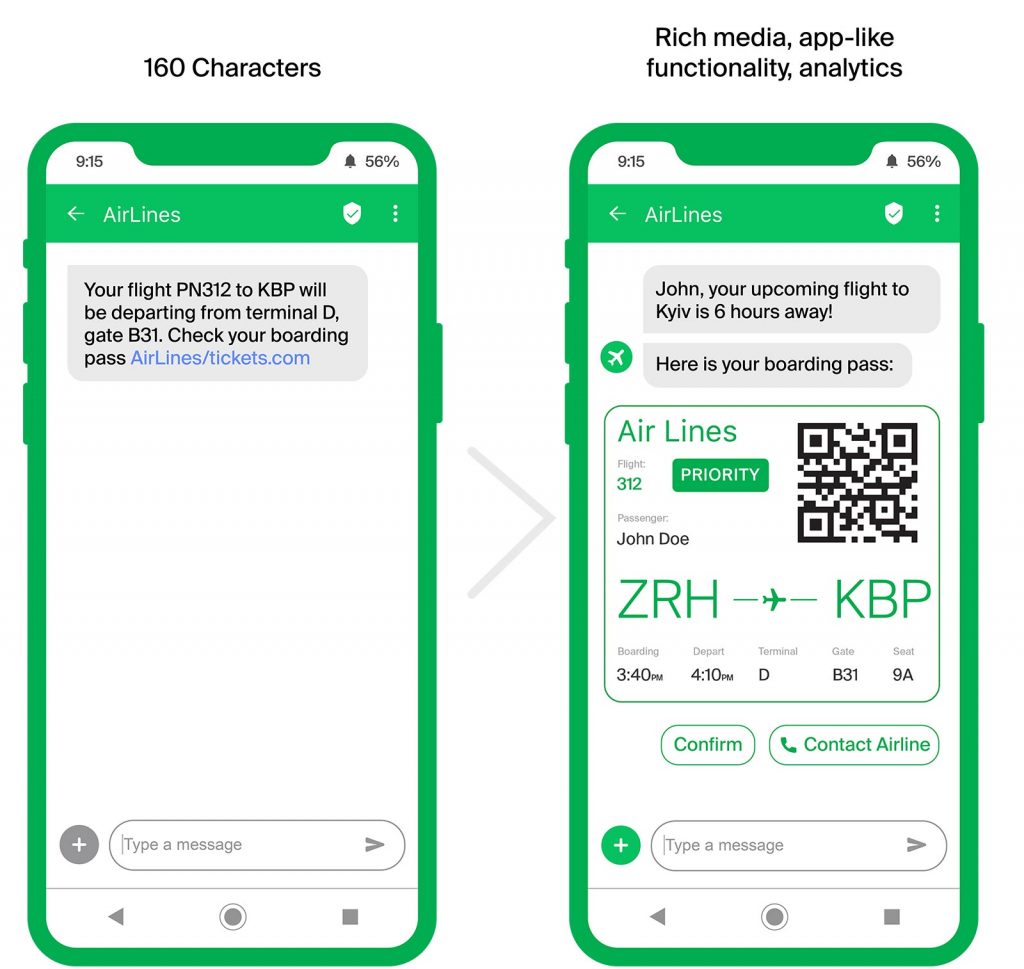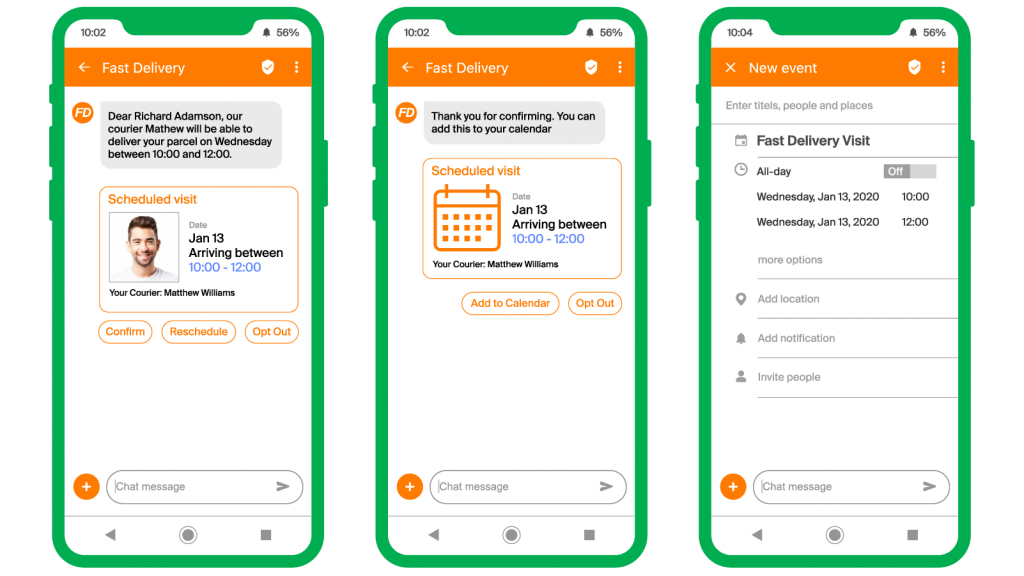Our world is increasingly digital and mobile. An estimated 5.1bn people own a mobile, and sophisticated smartphones account for 60% of these mobile connections. By 2025 this share will increase to 79% — with the increase in total phone ownership this equates to 4.5bn people worldwide using smartphones.
Capitalising on this growing ubiquity, operators have united with developers and handset manufacturers to create Rich Communication Services (or RCS), a new global messaging standard. The result is a content-rich format that has steadily grown to encompass a suite of Business-to-Consumer tools, as stakeholders come to recognise the importance of mobile to the brand-customer relationship. RCS messaging is a complete upgrade to SMS messaging that includes more engaging content, better functionality, and improved feedback and data.

Such an offering couldn’t be more critical at this time. A study by the GSM Association found that while 69% of people consider SMS to be a convenient way to receive updates from a company, 61% wished it had more functionality. SMS comes built-in to the phone, unlike messaging apps that need to be downloaded, but it lacks their flexibility and sophistication.
The majority of today’s customers also expect marketing and advertising to be as visual as possible. Moreover, two thirds of people “like to make [their] conversations as exciting as possible” and an equal number like to feel they are part of a conversation, rather than being part of an automated process.
Despite these reservations, users still prefer SMS over any other channel: SMS can boast 4.7bn monthly active users, more than the 3.25bn that WhatsApp, Facebook Messenger, WeChat and Viber have between them. Plus, SMS has a better chance of connecting: mobile messages are 35x more likely to be opened than emails. It’s therefore no surprise that RCS is steadily gaining traction, with 310 million users worldwide already using the technology, and dozens of companies, and from Subway in the US to Deutsche Telekom in Germany, launching B2C marketing and customer service campaigns using RCS business messaging benefits.
Since SMS messaging is one of the most important communications tools available, and RCS messaging adds many new possible uses, it could not be more imperative for companies to understand and exploit the opportunities presented by the latest technology.
The basics
RCS combines the features of the most popular messaging apps (plus several unique features) into one channel that promises to match the reach of SMS, avoiding the lack of standardisation that afflicts the messenger market. RCS can deliver images (including GIFs), video, interactive “rich cards” (which can be collected into catalogue-like carousels), branding, and more. It also integrates with a host of smartphone services and apps like geolocation, maps, and calendars.
By judicious use of these features, RCS can provide the means with which to address multiple problems facing modern enterprises. Excellent customer service can be a key differentiator, but the costs of providing this can be onerous — companies globally spent $16.28 billion on call centre software alone in 2018. And this is still not enough, since there is a strong desire on the part of customers to get an immediate response, and even the best-staffed customer service centre will inevitably need to put some callers on hold. New approaches are clearly needed, and RCS offers tools that help reduce these costs while optimising and enhancing the whole customer service process.
Rich media means more useful content
The idea of rich content doesn’t just refer to more interesting text messages; it also means more useful and engaging applications. Companies can significantly enhance their interactions with customers in many ways, just by using images and video.
Videos can be used to demonstrate product features to improve customer onboarding, thereby improving engagement and brand loyalty. Customers are much more likely to return to a company if their previous experience was positive.
Merely adding images can make B2C communications more informative or simply more engaging. They can also add a lot of extra value to your messages. For example, using QR codes and barcodes adds another level of utility, enabling companies to offer their customers a new level of service. Some forward-thinking companies have used them to deliver tickets for events and concerts.
This can be incredibly valuable since it simplifies and streamlines the customer experience. Users can purchase tickets (including via the RCS channel — more on that later) and have them sent as an RCS message consisting of event details and a QR code. Not only will this serve as their entry ticket, but the message can include buttons that enable the user to add a reminder directly to their calendar, to change their seating assignments, or otherwise manage their reservation.
Companies can even increase security and confidence by sending a picture of their service personnel when they confirm an appointment. These messages can be further enhanced. RCS includes suggested actions — so these same appointment reminders and confirmations can offer a simple way to reschedule if the time does not suit the customer. Alternatively, if the time suits, the customer can add it directly to their calendar appointments.

Improve customer interactions
What has been most interesting to brands using RBM, however, is the format. Introduced in the GSMA’s RCS Universal Profile 2.0, support for chatbots enables enterprises to enter into a dialogue with customers that enhances the customer experience in several ways. Bots build on suggested actions by creating conversational flows, or use natural language processing to understand and respond to messages typed by the user in real-time.
Going beyond images and video to promote the product, marketers can have bots instantly respond to questions about goods and services. Conversational interactions can explain the benefits to users in ways that match their interests and expectations — because they guide the experience, either through the choices they make or by typing their own questions or keywords.
The idea is to recreate the interpersonal mobile messaging experience. This serves two purposes. Firstly, it makes it easier for customers to discover more about the product. They don’t need to search online or go to a physical store to find what they need (either of which could potentially result in them finding more or better information provided by competitors). Secondly, it establishes a positive relationship with the customer by demonstrating an eagerness to provide useful information.
Optimise customer care
But beyond marketing, chatbots allow companies to demonstrate their value to the client and vastly improve the customer experience. Bots don’t just have to answer inquiries about product features, they can also help troubleshoot the problems and issues of existing customers. Since over half of customers prefer to contact support via text, RCS chatbots are the ideal way to do this.
A bot is not limited in the number of people it can help at once, making the process generally more efficient. Customers no longer have to wait in a queue to get assistance, streamlining the process and improving their experience with the company. This efficiency has implications for both customer satisfaction and the company’s bottom line. In fact, one estimate puts the average cost of a customer service phone interaction at around $35 to $50. However, text chat with a live agent averages around $8 to $10 per session, while a chat bot can help cutting these expenses even further.
Of course, this option might not be perfect for the most challenging problems. However, bots can easily deal with the most common problems faced by users while handing off more complex issues to contact centre agents. These human agents, meanwhile, will also have more time and flexibility in helping solve such issues, because they no longer have to deal with routine problems and inquiries. This helps solve the problem of churn caused by a poor customer support experience. Yet it also improves staff retention, which further optimises support costs, since call centre staff turnover can be as high as 44% annually, and training replacement staff can cost from $5,000 to $7,000.
Best of all, bots are not limited in their operating hours. They are always on hand to respond to customers — whether with marketing materials or offering customer service — vastly improving the interaction.
Deeper, more meaningful connections
Discoverability is one of the key strengths of RCS (Rich Communication Services) — it allows customers to search for and find your company and initiate contact. Searchable lists of available chatbots are available, either through the Android messages platform or the mobile operator’s own RCS infrastructure. This improved visibility makes it much easier to get your message across to interested parties, beyond what is possible even with targeted advertising.
A discoverable chatbot, where the customer initiates contact, drives deeper, more valuable conversations. Because the customer has a higher intent in this scenario, retention and conversion rates are much higher, making each message more cost-effective.
Summary
In part two, we will study how the technology enables novel use cases and how you can better improve your interactions using RCS Business Messaging’s more informative feedback and user data.

